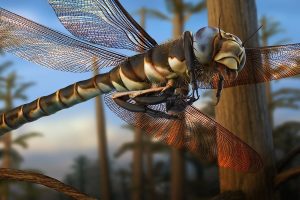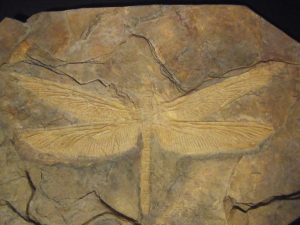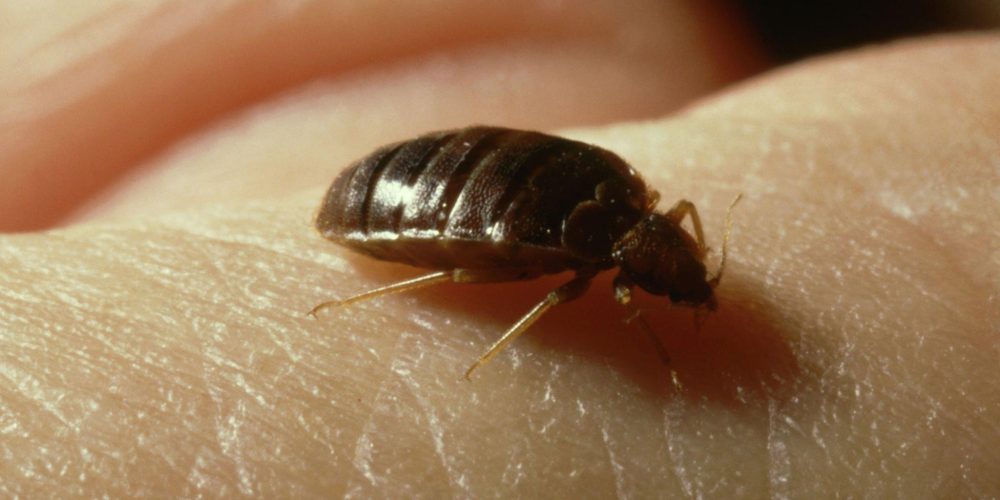About 300 million years ago, during the late Carboniferous period and long before the era of the dinosaurs, an almost completely different set of animals populated the planet from the ones we know today. Some of the most intriguing creatures to live during this period were called Meganeura monyi, otherwise known as giant dragonflies. These monstrously big insects resembled modern dragonflies but were much, much bigger. In fact, they are considered to be the largest insects that ever lived on our planet.
First discovery
Actually, despite the fact that Meganeura monyi looked quite similar to today’s dragonflies, the two species are not as closely related as you might initially think. Modern dragonflies and damselflies belong to the order Odonata, whereas giant dragonflies belonged to the sub-family Meganisoptera. The name “Meganeura” directly translates to “large-veined,” owing to the complex patterns of veins that have been found in giant dragonfly wing fossils.
The very first giant dragonfly fossils were discovered in 1880 in France, though other fossils have since been found in the USA, to be more specific, in Kansas and Oklahoma. Some fossils were also found in the United Kingdom. If you ever want to see a giant dragonfly wing fossil in person, take a visit to the Museum of Comparative Zoology on Harvard University’s campus. A fossilized giant dragonfly wing is part of their permanent exhibit!
Meganeura’s diet
Like their modern dragonfly counterparts, giant dragonflies were fearsome, carnivorous predators. Their heads had a pair of powerful mandibles or crushing organs, which allowed them to snap up and incapacitate their prey, which probably included the predecessors of today’s roaches and other prehistoric beetles. Their tough, spiny front limbs probably also evolved to help them hunt.
Scientists believe that even in their larval stages, giant dragonflies were accomplished, hunters. In their youth, giant dragonflies probably ate amphibian larvae and small water insects. However, like any insect, even the biggest of giant dragonflies weren’t immune to predation themselves. Scientists believed that primitive sharks, reptiles, and amphibians might have eaten young giant dragonflies. However, once they matured to their full size, it’s unlikely that many aerial predators would attempt to try to eat them.
Size and wingspan
As already said and as far as we know, giant dragonflies were the largest insects to ever roam our planet. Scientists believe that the dragonfly’s body was about 50 cm (20 inches) long, with a wingspan of up to approximately 70 cm (28 inches). That sounds crazy, doesn’t it? For comparison purposes, the biggest living dragonflies today are called Megaloprepus caerulatus, and their wingspans can reach lengths of up to 20 cm (8 inches).
In some way, we can be happy that Meganeura dragonflies don’t exist anymore today. With such an incredible size and their carnivorous nature, who knows, they might have tried to feed on us. It would certainly be frightening if a 70 cm (28 inches) large dragonfly tried to make a snack out of you. Adults could probably defend themselves, but small children not so much. But how on Earth did Meganeura evolve to become so outrageously big?
Why did they become so big?
Meganeura were not the only giant insects to live during the Carboniferous period. In fact, several other now-extinct, massive insect families lived at the same time as the Meganeura, including the Palaeodictyoptera. Palaeodictyoptera consisted of huge insects. The biggest insect of that group was Mazothairos, which was able to reach a wingspan of up to 55 cm (22 inches). But back to the last question: How did Meganeura and other giant insects of its time become so big? There are 3 popular theories that try to explain why the “giant dragonfly” could grow to be that big.
The first theory and probably to most popular one is saying that the high oxygen levels back then caused insects to become much bigger. During the Carboniferous period when Meganeura lived, the oxygen levels in Earth’s atmosphere were much higher than they are today, reaching up to 35% compared to today’s average level of about 20%. Invertebrate animals like dragonflies were able to take advantage of these elevated oxygen levels through their unique system of breathing.
Unlike vertebrate animals, which breathe through the lungs, insects breathe using a complex pathway of external pores and internal tubes. Oxygen enters through the pores and travels throughout the body in the tubes. Because the atmosphere was so oxygen-rich 300 million years ago, many scientists believe that prehistoric insects were able to breathe much more easily and grow to a much bigger size.
And as the oxygen level on Earth decreased, so did the size of these animals. There were already experiments done by scientists where they artificially increased the oxygen level in a controlled environment. The results were that the tested insects grew twice as big in only 1 generation.
According to another theory, insects back then could grow so big because of the lack of natural aerial predators such as birds, combined with a huge variety of smaller animals to feed of. There were simply no big enough aerial predators back then, so once Meganeura reached its full size, it also reached simultaneously to the top of the food chain.
The third theory that tries to explain the size of Meganeura is not as popular as the other two mentioned previously. This theory suggests that insects such as Meganeura developed in water in their early life stages, which eventually caused them to grow much bigger as adults. But as said, this theory is not as popular as the other ones but was still worth mentioning.
Extinction
The oxygen level theory is the most accepted theory by scientists due to scientific evidence. But the lack of natural aerial predators might have played a crucial role as well. However, the elevated oxygen levels of the Carboniferous period were both a blessing and a curse for the Meganeura. At the end of the Permian period, about 250 million years ago, the average global oxygen level dropped from its Carboniferous high. It’s likely that many giant insect species literally went extinct because their bodies were too big for them to breathe.
Only smaller species were able to survive. The rise of birds might have also contributed to the extinction of giant insects like the Meganeura. Although both birds and giant dragonflies could fly, birds were able to take off from the ground more quickly and were generally more agile and maneuverable than flying insects. This meant that they easily outcompeted the Meganeura for food, starving out the giant insects and contributing to their extinction.
However, it is not exactly clear when Meganeura first came into existence and when it died out. Unfortunately, there is still a lack of fossilized evidence to track down from when to when the giant dragonfly lived exactly. What we know so far is that it lived approximately 300 million years ago. But it might have also already lived long before that, maybe 320 million years ago. And it might have gone extinct long before the end of the Permian period 250 million years ago.
Or maybe it even survived the Permian-Triassic extinction event and lived during the early stages of the Triassic period. Although this is only theoretical speculation without evidence, we will hopefully find more fossils of this majestic creature so that we can better track down when it exactly lived.
It is certainly interesting to imagine if such giant insects could come back in the future. Maybe the oxygen levels will rise up to their Carboniferous levels again. This, however, might take several millions of years. Therefore it is much more likely that we could bring them back with science much earlier. Maybe in the near future, we will improve our technology to the extent that we can effectively develop these giants in laboratories. Only time can tell.

















